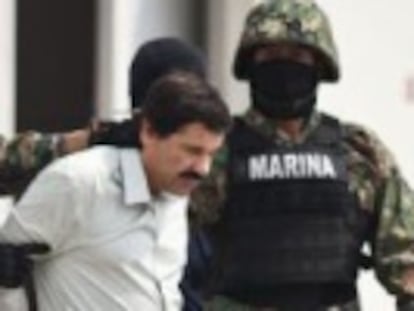The day ‘El Chapo’ met his captor
Mexico’s top cop recalls his conversation with the world’s most-wanted drug trafficker


It was 11am, February 22, 2014 inside the hanger used by the marines at Mexico City’s airport. The encounter was brief.
On one side of the table, a small man with a thick triangular moustache and a bruise on his forehead sat staring into space. He wasn’t handcuffed.
Facing him was Tomás Zerón de Lucio, the chief of the Criminal Investigation Agency (AIC) and Mexico’s top cop. He was the only officer in the room who wasn’t wearing a face mask.
After 13 years, the hunter finally had his game.
The questioning was only routine because officers immediately recognized the deep husky voice.
—What’s your name?
—Joaquín Guzmán Loera
—Aren’t you Archivaldo?
—Yes, Joaquín Archivaldo Guzmán.
“El Chapo,” the dreaded leader of the Sinaloa cartel and the most wanted trafficker on the planet, spoke hesitantly. When he was forced to undergo a handwriting analysis, he stumbled like a child when he wrote out his name. Archivaldo was nervous but also humiliated.
“In his town, he didn’t pass second grade. But he learned the rest while in jail,” explained Zerón.
It has been a year since the announcement of El Chapo’s arrest made headlines around the world and since then the AIC director has had to deal with other cases, some as thorny as the Iguala tragedy, in which 43 students were kidnapped and massacred last September in Guerrero state.
Recalling the operation that led to El Chapo’s arrest, the 52-year-old police chief sketches a diagram of overlapping circles: arrests, safe houses and tapped telephone lines.
El Chapo was apprehended in a bathroom, among a pink suitcase, a bottle of shampoo and a pile of clothes
The circles began closing in when an enemy of El Chapo told authorities that their most-wanted prize was hiding out in an apartment in front of the Mazatlán esplanade in Sinaloa.
When the marines stormed the home at 6.50am on February 22, 2014, El Chapo tried to hide in a bathroom. His wife and two-year-old twin daughters were in another room with a cook and babysitter.
The world’s public enemy number one was apprehended by marine officers among a pink suitcase, a bottle of shampoo and a pile of clothes.
Four hours later, El Chapo found himself face-to-face with one of the chief planners of the operation.
“What has been said about me is more fantasy than reality,” El Chapo said, while asking for hand cream and bottle of Perrier, which he gulped down.
The cartel chief said he got the bruise when he fled a safe house in Culiacán just days before his capture
Zerón asked him about the bruise on his forehead, thinking it may have occurred during his arrest. El Chapo denied it.
He got the bruise when he fled a safe house in Culiacán, the capital of Sinaloa, the state from where he oversaw his drug empire. Five days earlier, authorities closed in but he was able to allude them by escaping through a secret passageway hidden underneath a bathtub. From there, he made his way through an underground network of tunnels, carrying with him a backpack containing a bazooka and ammunition.
At one point he slipped, fell and bruised his head.
Outside, his bodyguard, Alejandro “El Bravo” Aponte Gómez, an army lieutenant who joined the drug trafficking cartel, was waiting from him.
It was then that El Chapo became suspicious of everyone around him and decided to get rid of his security detail. One by one his closest associates were captured.
El Chapo told Zerón that he had planned on hiding out at his ranch in the Sinaloa mountains but first wanted to see his wife, Emma Coronel, and two daughters. Authorities traced more than 100 phone calls and were able to pin down where El Chapo was going to be.
El Chapo has not accepted responsibility for any of his crimes and to this day hasn’t ratted on anyone
According to some witnesses, El Chapo entered the Mazatlán hotel in a wheelchair disguised as an old man.
“His world crumbled with his arrest,” said Zerón. “Since his escape from the Puente Grande prison, he had been on the run for 13 years.”
But despite this stunning police victory, El Chapo is still his own boss. He has not accepted responsibility for any of the crimes he has been accused of committing, and to this day hasn’t ratted on anyone.
—How come you didn’t have any money on you at the time of your arrest?
—I don’t need money. When I would ask for some, it would be brought to me. If I asked for a million pesos, they would bring me a million pesos.
The conversation at the hanger was interrupted because El Chapo was suffering from stomach problems. He had to be escorted to the bathroom by a marine officer. He came back walking straight.
Before he was taken away by helicopter to the Altiplano high security prison, El Chapo looked once again at his interrogator
—Can you tell me your name? It’s that you have treated me so well.
Following his arrest, El Chapo’s sons went on vengeance rampages — bodyguard El Bravo was shot six times in the head; many other bodies were found tortured and mutilated.
In prison, when asked his occupation, El Chapo simply responded as he always has: “I am a farmer.”
El Chapo’s shoes go unfilled
The Sinaloa cartel has apparently yet to decide who among the organization's bigwigs will succeed El Chapo. In 2009 Forbes magazine listed El Chapo as one of the richest men in the world.
In terms of hierarchy, Ismael “El Mayo” Zambada, who has been in the drug business for half a century but never seen a jail cell, should take on the role. But anti-drug experts say the Sinaloa cartel has become a more horizontal organization with various regional heads operating on the same level.
One who has become very influential in Sinaloa is Dámaso "El Licienciado" Alonso. El Chapo's sons and those of El Mayo also form part of the cartel's hierarchy.
Another figure, Juan José Esparragoza, known as “El Azul,” should also be on the list but, according to his sons, he died at the age of 66.
Whoever it may be, they will never be able to fill the vacuum left by El Chapo.
Tu suscripción se está usando en otro dispositivo
¿Quieres añadir otro usuario a tu suscripción?
Si continúas leyendo en este dispositivo, no se podrá leer en el otro.
FlechaTu suscripción se está usando en otro dispositivo y solo puedes acceder a EL PAÍS desde un dispositivo a la vez.
Si quieres compartir tu cuenta, cambia tu suscripción a la modalidad Premium, así podrás añadir otro usuario. Cada uno accederá con su propia cuenta de email, lo que os permitirá personalizar vuestra experiencia en EL PAÍS.
En el caso de no saber quién está usando tu cuenta, te recomendamos cambiar tu contraseña aquí.
Si decides continuar compartiendo tu cuenta, este mensaje se mostrará en tu dispositivo y en el de la otra persona que está usando tu cuenta de forma indefinida, afectando a tu experiencia de lectura. Puedes consultar aquí los términos y condiciones de la suscripción digital.









































